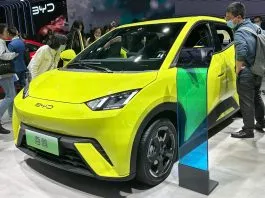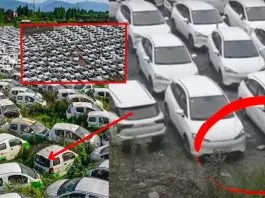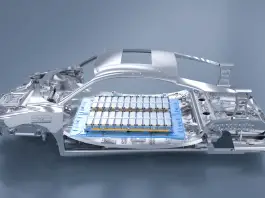EVs were making headlines for causing fires, despite the fact that they are much safer than their IC engine counterparts. Additionally, range anxiety is another fear, because nobody likes being stranded because of a dead battery. However, a recent video shows a new problem with a particular EV.
According to CarNewsChina, the Cao Cao 60, a Chinese all-electric car, was captured on camera losing its high-voltage battery pack while in motion. The incident took place on the 2nd Ring Road in Chengdu, Sichuan Province.
In the brief footage, the white EV can be seen coming to a stop roughly 65 feet (20 metres) after losing its primary power supply, which could indicate that the vehicle just rolled to a stop with the help of inertia. Fortunately, there was no fire caused, or any damage seen.
The SUV is left stuck in the middle of the highway, and the battery pack is visible lying on the pavement. The only thing the driver can do is wait for help.

Table of Contents
Reasons for This Tragedy
There could have been a number of causes for this tragedy. The top and bottom surfaces of the battery pack appear to be made of substantial metal sheets. For a lightweight profile, it could also be a composite carbon fibre material. There are numerous holes visible, indicating that fasteners are used to attach the battery pack to the underside of the EV. To facilitate quicker battery swaps, it might even be a quick-release clamping system.
It is also likely that the battery replacement was not done in accordance with the manual’s instructions. It’s possible that the fasteners were already loose and that vibrations caused them to become even more loose. The weight of EV battery packs can put a lot of strain on the fasteners. For comparison, the battery pack for a Tesla Model S weighs more than half a tonne.
Battery Swap Technology
To make charging faster and increase the time vehicles can be used for ride-hailing, the company Geely introduced the Cao Cao 60. It has a battery pack that can be easily replaced. Ironically Cao Cao emphasised the new 60’s deep customization for the ride-hailing industry and its extremely long, confirmed service durability of 600,000 km during the unveiling.
The car is made by Ruilan Auto, a different Geely brand that formerly went by the name Maple. Additionally, Geely’s tagline for its battery swap business is “separation of vehicle and electricity,” which is the perfect fit for this specific circumstance. The numerous brands that make up Geely Holding include Lynk&Co, Zeekr, Volvo, Lotus, and many more.
The vehicle or the exchange system may not be compromised, it is important to remember, as all automakers have made mistakes in the past and have since fixed them. The Tesla Model Y whose steering wheel came off a week after delivery was one of these moments. Nevertheless, the American EV manufacturer later replaced the vehicle with a new one
Major Accident Could Have Been Caused
On a congested roadway, an EV losing its battery pack may have caused a serious collision. The SUV stopped in the centre of the road, potentially causing a multiple-vehicle collision. Another risk aspect is the big battery pack that is laying on the road. This specific battery is bulky, flat, and primarily grey in colour to fit the surrounding landscape. All in all, it is a hazardous piece of roadside litter that might wreck a car and make any crash recovery more hazardous because it is an active battery.
Thankfully, there were no such occurrences. Benefits of battery switching include rapid refuelling. The cost of the battery pack is not borne by the user. Taxis can spend more time travelling rather than waiting at a charging station thanks to battery switching. Hopefully, this incident of the battery discharging while driving was an isolated occurrence. Geely will probably discover a long-lasting solution after making the essential inquiries.
More About Cao Cao 60 EV
This year on March 29, Geely unveiled the Cao Cao 60, the first car under the new Cao Cao Auto brand. It has swappable batteries and a 415 km CLTC range. Starting at 119,800 yuan or $17,500. According to Cao Cao Auto, the 60 has been extensively customised for ride-hailing and as mentioned earlier, has a certified, extremely extended service life of 600,000 km. It is estimated that the battery swap takes roughly 60 seconds, which is astounding given that the Generation 3 Nio swap station requires 3 minutes to complete the exchange. Moreover, there is 500 litres of boot space.
Talking about the tech onboard, the vehicle has ‘anti motion sickness technology’ and two small LCD screens, one in front of the copilot and one in the back. The arrangement of the interior is comparable to that of the Geely Emgrand L; however, it differs in that the primary driver’s seat has a ventilation feature and an integrated LCD instrument. The Caocao 60’s front seat back features cup holders, folding hooks, charging ports, and supports one-button adjustment of the passenger seat. Its headroom is equivalent to that of the Buick GL8, while its lateral space is comparable to that of the Honda Odyssey.
Cao Cao 60 has a closed front face with the name Maple English on the head, a bar-type light group at the back with integrated green trim, and a reverse radar installed in the bumper.
Conclusion
The incident involving the Chinese EV’s battery pack dropping while in motion serves as a valuable reminder about the significance of stringent quality control and testing in the realm of electric vehicles. This incident highlights the importance of ensuring the reliability and safety of crucial components. As the EV industry continues to evolve, it is crucial to prioritize robust quality assurance measures to guarantee the integrity and performance of electric vehicles, enhancing their overall safety on the road.



